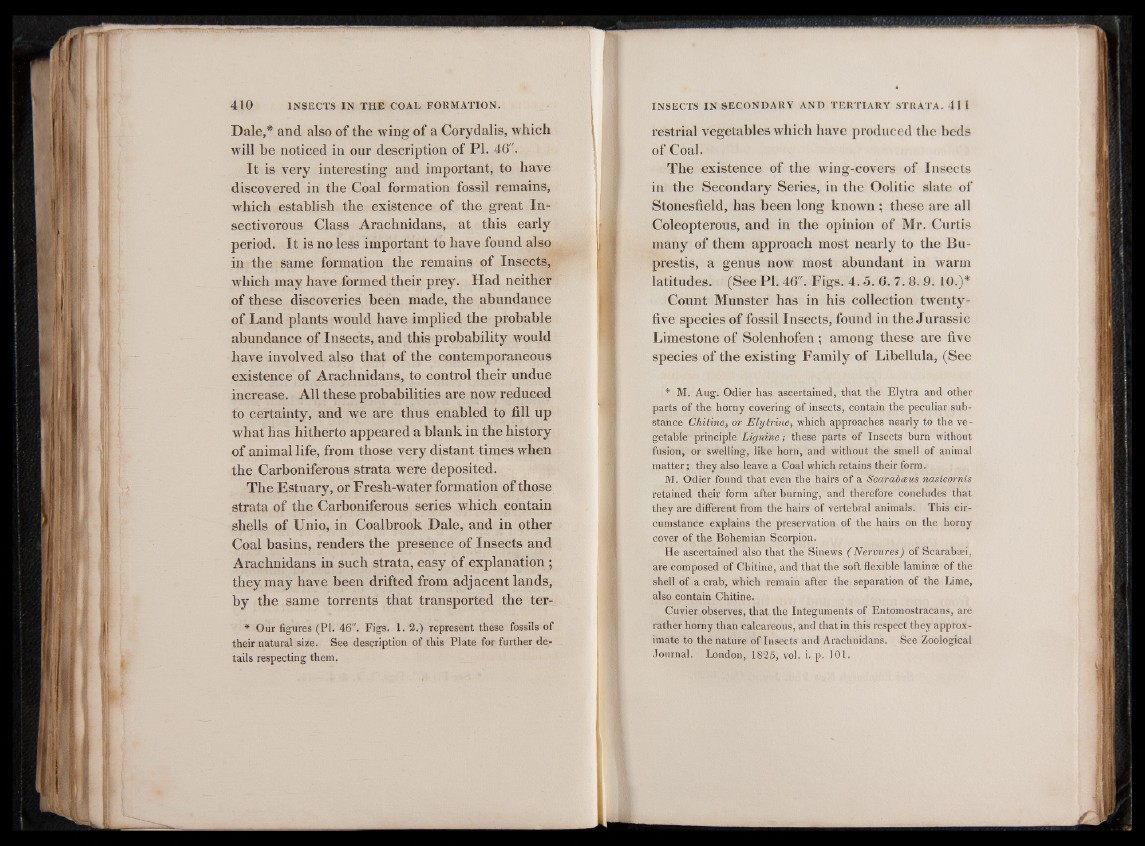
Dale,* and also of the wing of a Corydalis, which
will be noticed in our description of PI. 46".
It is very interesting and important, to have
discovered in the Coal formation fossil remains,
which establish the existence of the great Insectivorous
Class Arachnidans, at this early
period. It is no less important to have found also
in the same formation the remains of Insects,
which may have formed their prey. Had neither
of these discoveries been made, the abundance
of Land plants would have implied the probable
abundance of Insects, and this probability would
have involved also that of the contemporaneous
existence of Arachnidans, to control their undue
increase. All these probabilities are now reduced
to certainty, and we are thus enabled to fill up
what has hitherto appeared a blank in the history
of animal life, from those very distant times when
the Carboniferous strata were deposited.
The Estuary, or Fresh-water formation of those
strata of the Carboniferous series which contain
shells of Unio, in Coalbrook Dale, and in other
Coal basins, renders the presence of Insects and
Arachnidans in such strata, easy of explanation ;
they may have been drifted from adjacent lands,
by the same torrents that transported the ter-
* Our figures (PI. 46". Figs. 1. 2.) represent these fossils of
their natural size. See description of this Plate for further details
respecting them.
restrial vegetables which have produced the beds
of Coal.
The existence of the wing-covers of Insects
in the Secondary Series, in the Oolitic slate of
Stonesfield, has been long known ; these are all
Coleopterous, and in the opinion of Mr. Curtis
many of them approach most nearly to the Bu-
prestis, a genus now most abundant in warm
latitudes. (See PI. 46". Figs. 4.5. 6. 7. 8. 9. 10.)*
Count Munster has in his collection twenty-
five species of fossil Insects, found in the Jurassic
Limestone of Solenhofen ; among these are five
species of the existing Family of Libellula, (See
* M. Aug. Odier has ascertained, that the Elytra and other
parts of the horny covering of insects, contain the peculiar substance
Chitine, or Ely trine, which approaches nearly to the vegetable
principle Lignine; these parts of Insects burn without
fusion, or swelling, like horn, and without the smell of animal
matter; they also leave a Coal which retains their form.
M. Odier found that even the hairs of a Scarabceus nasicornis
retained their form after burning, and therefore concludes that
they are different from the hairs of vertebral animals. This circumstance
explains the preservation of the hairs on the horny
cover of the Bohemian Scorpion.
He ascertained also that the Sinews (Nervures) of Scarabsei,
are composed of Chitine, and that the soft flexible laminae of the
shell of a crab, which remain after the separation of the Lime,
also contain Chitine.
Cuvier observes, that the Integuments of Entomostracans, are
rather horny than calcareous, and that in this respect they approximate
to the nature of Insects and Arachnidans. See Zoological
Journal. London, 1825, vol. i. p. 101.